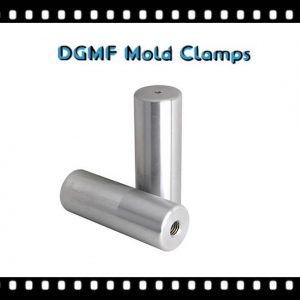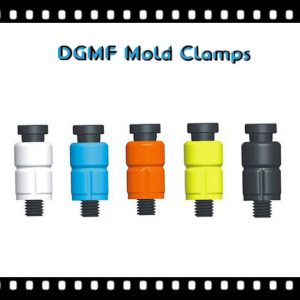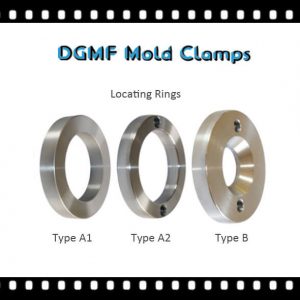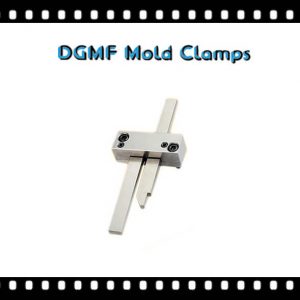Lock Mold Components
Lock Mold Components Supplier
DGMF Mold Clamps Co., Ltd is the Lock Mold Components supplier and mould clamps manufacturer in China.
The Lock Mold Components series from DGMF Mold Clamps Co., Ltd includes mold parting lock, latch locking unit, etc.
Mold Parting Lock
The resin shutter nylon mold parting lock is a part that adjusts the friction between the template and the nylon sleeve by locking the tapered bolt.
Description of mold parting lock (shutter nylon screw)
1. The friction between the template and the resin is adjusted by the inclined screw, and the mold can be closed about 50,000 times by about 1/4 turn.
2. The mold parting lock is easy to disassemble, simple, and low in price.
3. This device is also used on the small nozzle plate and the hit plate or the second ejection of the small nozzle or sliding seat.
4. If the mold weight is below 100KG, use 4pcs of 12mm, use 4pcs of 16mm for below 500KG, use 4pcs of 20mm for below 1000KG, and increase to more than 6pcs if it exceeds 1000KG.
5. The resin part lock is embedded in the male template about 3 cm, and the hole of the female mold is processed to the range of +0.10mm with an H7 reamer.
6. The surface of the master mold should be processed into an R shape. If the C surface is chamfered, the durability will be poor.
7. Do not add oil to the resin surface, because adding oil will reduce the friction.
Part lock mold rubber plug screw
By locking the vertebral bolts, the friction between the template and the nylon sleeve can be adjusted. The product uses a special nylon material, so it has good wear resistance and heat resistance.
Although the heat-resistant temperature of the nylon sleeve is 150 ℃, it is constantly subjected to the tightening stress of the tapered bolt during actual use. The effect of this will cause the durability of the nylon sleeve to decrease, so please use it below 80℃.
Installation method of mold parting lock screw
Embed the nylon sleeve in the movable mold template for about 3mm, and finish the inner surface roughness of the fixed mold template hole to round the template surface inserting hole R. If C chamfering, its durability will be reduced.
What is the function of the nylon mold parting lock (shutter)?
Locking effect
It is usually used to add nylon mold parting locks between the A and B plates on the three-plate mold so that there is a fixed riveting force between the A and B plates. When the mold is opened, the mold cannot be opened first due to the nylon buckle. , So that the nozzle plate opens first.
Resin mold parting lock screws are also called nylon mold clamping buttons, resin mold clamping devices, nylon resin shutters, nylon rubber plug screws, etc.
The resin mold parting lock screw is a part that adjusts the friction between the template and the nylon sleeve by locking the tapered bolt.
1. The friction between the template and the resin is adjusted by the inclination screw, and the mold can be closed and closed for about 50,000 times by about 1/4 turn;
2. Make the removal of the mold device easy and simple;
3. This device can also be used on the small nozzle plate and the hitting plate or the two-stage ejection small nozzle or sliding seat workpiece;
4. Use 12D-4 pieces for mold weights below 100K, 16D-4 pieces for molds below 500KG, and 20D-4 pieces for molds below 1000KG;
5. Colors: white, yellow, orange, blue, blue can withstand a high temperature of 160 degrees.
What are the advantages and disadvantages of mold parting lock nylon screws?
Advantages of mold parting locks
1. High mechanical strength, good toughness, high tensile, and compressive strength. The specific tensile strength is higher than that of metal, and the specific compressive strength is comparable to that of metal, but its rigidity is not as good as that of metal.
The tensile strength is close to the yield strength, more than twice as high as ABS. It has a strong ability to absorb shock, stress, and vibration, and its impact strength is much higher than that of general plastics and better than acetal resin.
2. Outstanding fatigue resistance, the parts can maintain the original mechanical strength after repeated bending. Common escalator handrails and new bicycle plastic rims are often used on occasions where the periodic fatigue effect is extremely obvious.
3. High softening point and heat resistance (such as nylon 46, high crystalline nylon has a high heat distortion temperature and can be used for a long time at 150 degrees. After PA66 is reinforced with glass fiber, its heat distortion temperature can reach 250 degrees or more).
4. Smooth surface, low friction coefficient and wear resistance. It is self-lubricating when used as a movable mechanical component, with low noise, and can be used without lubricant when the friction is not too high;
If you really need to use lubricants to reduce friction or help dissipate heat, you can choose water, oil, grease, etc. Therefore, it has a long service life as a transmission component.
5. Corrosion-resistant, very resistant to alkalis and most salt liquids, also resistant to weak acids, engine oils, gasoline, aromatic compounds, and general solvents, inert to aromatic compounds, but not resistant to strong acids and oxidants. It can resist the erosion of gasoline, oil, fat, alcohol, weak base, etc., and has a good anti-aging ability. It can be used as a packaging material for lubricating oil and fuel.
6. It is self-extinguishing, non-toxic, odorless, has good weather resistance, is inert to biological erosion, and has good antibacterial and antifungal capabilities.
7. Has excellent electrical properties. Good electrical insulation. Nylon has a high volume resistance and high breakdown voltage. It can be used as a power frequency insulating material in a dry environment, and it has good electrical insulation even in a high humidity environment.
8. The parts are light in weight, easy to dye, and easy to shape.
Disadvantages of mold parting locks
1. Poor water absorption and poor dimensional stability.
2. Poor low-temperature resistance.
3. Poor antistatic property.
4. Poor heat resistance.
Latch Locking Unit
The latch locking unit is to fix the AB plate of the mold from opening the first time, prevent the mold from moving, and play a role of customization and protection.
The latch locking unit is a clamping device used to fix molds. It is widely used in stamping molds and die-casting molds in industries such as auto parts and equipment manufacturing.
Latch locking unit technical information
1. Workpiece material
Die steel
2. Dimension accuracy
Accuracy can reach ±0.002mm, total length accuracy can reach ±0.003mm
3. Workpiece hardness
High-temperature quenching: hardness HRC59°-61°
4. Product features
High hardness, good toughness, and strength, excellent wear resistance.
5. Manufacturing process
Turning/milling/grinding/CNC turning/deep hole drilling/circular grinding/punching machine/wire cutting/discharge
6. Surface treatment
Polishing/titanium plating/blackening
7. Product use
The service life is greatly improved, and it is suitable for molds in a high-temperature working environment.
The main standards of the latch locking unit are DME/R standard, HASCO/R standard, MISUMI/R standard, TAIWAN/R standard.
How to install the latch locking unit?
The latch locking unit is a clamping device used to fix the mold, prevent the mold from moving, and play the role of customization and protection. The latch locking unit is a mold opening auxiliary mechanism.
Correctly and in accordance with the installation sequence of the process will help the mold not to deform, and it has a great effect on improving the quality of the entire mold product. Therefore, the installation must be professional.
So, how to install the latch locking unit correctly? Specifically, there are the following seven steps or precautions.
1. The latch locking unit is a precision device, please position it accurately and install it symmetrically.
2. If it is not installed symmetrically on the mold, it may cause a single set of latch locking units to be stressed, and uneven force (even) will cause the latch locking unit to break.
3. The latch locking units are precision fit, please do not use them with other self-professed parts.
4. If the mold needs to be repaired and changed, please remove the latch locking unit before proceeding with subsequent operations.
5. The installation of the main body, pull rod, and insert rod is parallel to the direction of mold opening movement.
6. The latch locking units are precisely matched and should be installed on the precise mold base.
7. After installation, please test the opening and closing sequence slowly on the clamping machine or injection molding machine to ensure that it is correct.
The structure of the mold is very complicated, and there are too many accessories, large and small, but each is very important. The latch locking unit is one of them. Therefore, in addition to understanding the mold components, we must also understand their use and principle.
Use and classification of standard components of latch locking unit
With the rapid development of industry, molds that serve industrial production have also developed rapidly in recent years, and many molds are used in manufacturing. latch locking unit is one of them.
1. Fine nozzle latch locking unit
Runners and gates are not on the parting line, usually directly on the product, so it is necessary to design an additional set of nozzle parting lines, the design is more complicated and the processing is more difficult, generally depending on the product requirements choose a fine nozzle system.
2. On the mold line, it is demoulded together with the product when the mold is opened. The design is the simplest, easy to process, and low cost, so more people use the large nozzle system for operation.
3. Hot runner mold latch locking unit.
The structure of this type of latch locking unit is roughly the same as the nozzle. The biggest difference is that the runner is in one or more hot runner plates and hot nozzles with a constant temperature. There is no cold material demoulding, and the runner and gate are directly on the product.
Therefore, the runner does not need to be demolded. This system is also called a nozzle less system, which can save raw materials, and is suitable for situations where raw materials are more expensive and products require higher requirements, and the design and processing are difficult, and the cost of mold clamping is higher.
Latch locking unit standard
DME/R latch locking unit standard
KL-1-1-70,
KL-1-2-90,
KL-1-2170,
KL-1-2-220,
KL-1-2-270,
KL-1-2-256 with KU-1- 1-140,
KU-1-1-204,
KU-1-1-254,
KU-1-2-200,
KU-1-2-250,
KU-1-2-300,
KU-2-2- 400,
KL-1-3-120,
KL-1-3-170,
KL-1-3-220
HASCO/R latch locking unit standard
Z171/1, Z171/2, Z171/3, Z174/50/90/0, Z174/50/90/20HV,
Z174/50/130/0, Z174/50/130/50HV, Z174/80/117/ 0, Z174/80/117/32HV,
Z174/80/167/0, Z174/80/167/75HV, Z174/100/145/0,
Z174/100/145/50HV, Z174/100/195/0. Z174/100/195/80HV,
MISUMI/R latch locking unit standard
MPLK10,
MPLK20,
MPLK30,
MPLK60,
MPLK80S,
MPLK100,
MPLKS30,
MPLKS60,
MPLKS80S,
Extended type MPLK/80,
MPLKS80,
PPLSW,
PPLS,
PPLM,
PPLL,
PROGRESSIVE/R latch locking unit standard
RRPL-135,
RRPL-135-40,
RRPL-140
STRACK/R latch locking unit standard
Z3-1,
Z3-11,
Z3-2,
Z3-21,
Z3-3,
Z3-31,
Z5/0,
Z5/1,
Z5/2,
RABOURDIN/R latch locking unit standard
REF460-140,
REF460-204-90,
REF460-204-170,
REF460-254-220,
REF-461-90,
REF-461-170,
REF-461-220,
REF462-140,
REF462-204,
REF462- 254,
DME-EOC/R latch locking unit standard
DDKL2811,
DDKL2812,
DDKL2821,
DDKL2822,
DDKL3411,
DDKL3412,
DDKL3421,
DDKL3422,
DDKL4511,
DDKL4512,
DDKL4521,
DDKL4522,
TAIWAN/R latch locking unit standard
DTP03A,
DTP03B,
DTP03C,
DTP03D,
DTP03E,
DTP03F,
DTP04A,
DTP04B,
DTP05-100,
DTP05-200,
DTP05-300,
DTP05-600,
DTP06,
DTP07A,
DTP07B,
DTP08A,
DTP08B,
etc.
DGMF Mold Clamps Co., Ltd manufactures the mold clamps, and supplies the injection mold components, such as Clamps, Toggle Clamps, C Clamps, Pins, Bushings, Positioning Components, Lock Mold Components, Reset Extrusion, Cavity, and Core Components, Coolings, Die Press Components, Punch And Die, Guide Components, Self-lubricating Components, Springs, Machine Tools, Machine Mounts, gate valves, Vises, Fasteners, Lifting, Bolts, Nuts, Washers, etc.
Contact the DGMF Mold Clamps teams for more details about the lock mold components such as lock mold components specifications, lock mold components pricing, lock mold components inventory, etc.
Showing all 4 results




